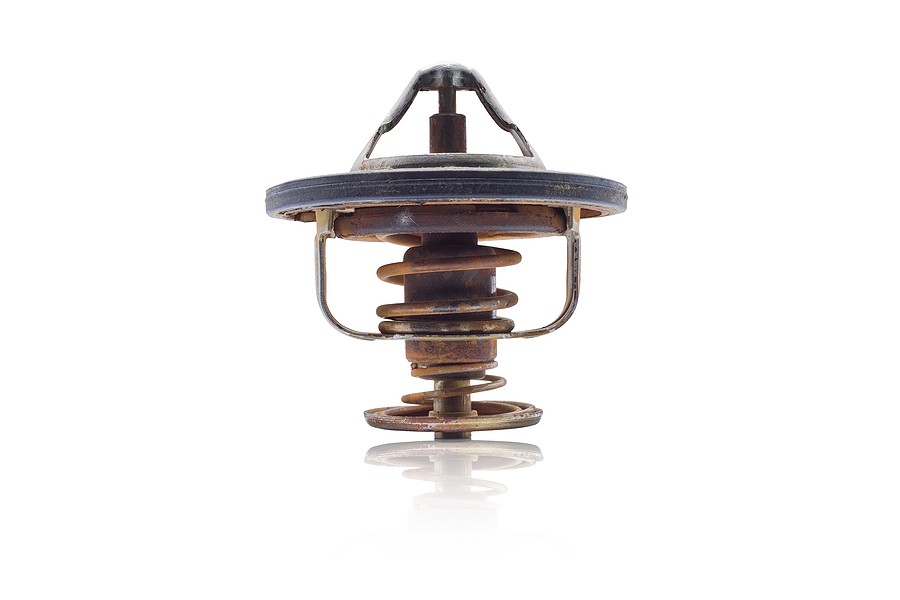Your vehicle's thermostat is responsible for maintaining the engine's temperature within the operating range, as specified by the vehicle's owner's manual. As the thermostat gets older, it can get stuck open or stuck closed, which affects the overall engine's performance.
While the stock-opened thermostat can result in engine problems, a stuck-closed thermostat might lead to engine self-destruction within a short period.
There are many signs of a bad thermostat that you must keep an eye for including, frequent change in engine's temperature, engine overheating, and a significant drop in your engine's performance.
In this article, we will provide you with an overview of the thermostat's characteristics along with the way it works. Then, we will summarize the common signs of a bad thermostat. Besides, we will provide a cost estimate for replacing your vehicle's thermostat and answer additional related questions.
What is the thermostat, and how does it work?
In any vehicle, the engine should be within a specific range of temperatures to ensure the best operation and to avoid overheating. As the engine runs, it's temperature rises gradually till it reaches a point where it needs to cool down. If the engine passes a certain temperature level, it can overheat and get self-destroyed.
The vehicle's thermostat is responsible for cooling down the engine by allowing the coolant to pass around it. The thermostat works as a valve that opens when the engine's temperature is high and closes when the engine's temperature is within the specified range.
You can locate your vehicle’s thermostat somewhere between the top radiator hose and the engine. When you first start your vehicle, the thermostat starts closed and does not allow any coolant to pass around the engine. As the engine runs and gets hotter, the thermostat automatically opens, allowing the coolant to bring the engine’s temperature down.
Like any other vehicle components, the thermostat can get damaged or drop its performance. For example, it is very common to have a stuck open or stuck closed thermostat. As a result of a stuck closed thermostat, the coolant will not be allowed to flow around the engine at the right time; Therefore, the engine will continue to overheat and can get damaged quickly.
On the other hand, if the thermostat is stuck open, the coolant will continuously flow around the engine, preventing it from reaching the required temperature.
While a stuck open thermostat does not cause engine damage immediately, the engine damage can happen eventually.
Signs of a bad thermostat
Now you fully understand what the thermostat is and how it works, it is important to maintain a perfectly working thermostat to avoid complete engine failures. In this section, we will provide you with an overview of the most reported signs of a bad thermostat.
- Sudden engine overheating along with high-temperature gauge reading
As we mentioned before, the thermostat can get stuck open or get stuck closed. One of the most alarming signs indicating a stuck close thermostat is engine overheating.
While engine overheating can happen due to many different reasons, a faulty thermostat might be the primary cause in most scenarios. As of thermostat stuck closed, the coolant will not flow around the engine, and your engine will overheat within less than 15 minutes.
That being said, if your engine started overheating along with a high-temperature gauge reading, you must stop the vehicle and contact a professional mechanic as soon as possible.
- Temperature fluctuating
Along with a stuck open or stuck closed thermostat, the thermostat might not be able to read the accurate engine’s temperature. As a result, the thermostat will not know when it should allow the coolant to pass and when not to. Therefore, one of the common signs that you might notice with this problem is a sudden fluctuation in the engine’s temperature.
For example, your engine’s temperature might be abnormally high at some point; then, the engine’s temperature might drop drastically to an abnormally low temperature without a clear reason or warning sign. In that case, it is your vehicle's thermostat that needs to be checked, repaired, or replaced.
- Issues with the engine's performance
As we mentioned earlier, for the engine to work efficiently, it has to be within a certain range of temperature, as specified in the vehicle’s owner’s manual.
If the thermostat is not able to maintain this range of temperature, you will see a drop in the overall engine's performance. Furthermore, you will also notice a significant drop in the fuel economy as you will need to refill your vehicle much more often than before.
If you noticed any of the mentioned symptoms, the best decision for you is to take your vehicle to a professional mechanic and get it inspected and repaired as needed. While it's important to take the vehicle to a professional mechanic, many people find it easy to perform DIYs and check for their thermostat's performance.
Can you drive with a bad thermostat?
The answer is yes, and no.
As we mentioned earlier, the thermostat can get stuck open or stuck closed. If your vehicle's problem is with is a stuck-opened thermostat, then you can still drive your vehicle. However, your vehicle’s engine will be at low performance, especially in winter days.
On the other hand, if your vehicle's problem is with a stuck closed thermostat, then your engine overheats within less than an hour. Engine overheating can lead to significant engine self-destruction. Therefore, if the latter is your case, you must get your vehicle inspected by a professional mechanic as soon as possible.
How do I know if my thermostat will water pump is bad?
While there are similar symptoms for both a faulty thermostat and a faulty water pump, there are unique symptoms that are associated with each one of them separately.
For example, a faulty water pump will show a water leak around the front center of your vehicle. Furthermore, the faulty water pump's pulley might be loose, making weird whining noises. Finally, you might see steam coming out of your vehicle’s radiator due to a faulty water pump.
On the other hand, if the problem is due to your vehicle’s thermostat, you might notice that your vehicle's engine’s temperature frequently fluctuates along with very poor engine performance.
How much does it cost to replace a thermostat?
Replacing the thermostat, can you acquire about $90.00 to $100. However, the actual cost of the parts is between $30 and $60.00.
If you don't already know, vehicle repairs costs are divided into two groups: parts costs and labor costs. In many situations, labor costs are much higher than the parts costs.
Therefore, many people prefer to perform repairs on their own using online DIYs. Thermostat replacement is one of these simple repairs that you can do on your own.
It is important to note that if you don't have the required skillsets for replacing a thermostat, you might introduce additional problems to your vehicle resulting in higher repair costs. Furthermore, experts indicate that any DIY might fail for the first time.
Therefore, it is not recommended to replace your vehicle's thermostat until you are confident that you can do it, even though the process is not complicated.
Will a car run hot without a thermostat?
If you know how the thermostat works, you will know for sure that the car will never warm up without the thermostat.
This is because the thermostat is responsible for controlling the coolant flow around the engine. In other words, the thermostat would remain closed until the engine reaches the top allowed operating temperature. Then, the thermostat would open, allowing the coolant to run around the engine to bring it’s temperature down.
If the vehicle does not have a thermostat, the coolant will run continuously around the engine, causing it to cool down all the time. As a result, the engine will never warm up or overheat.
What would cause a vehicle to run hot?
Vehicle running hot can be due to many different reasons. As a rule of thumb, when your vehicle runs hot, it's a clear issue with the cooling system. The cooling system is not able to bring the engine temperature to the operating level.
Vehicle running hot can be due to a problem with any component of the cooling system.
For example, a coolant leak, a faulty radiator, a broken fan, a faulty water pump, or a broken coolant hose might be the culprit.
Your vehicle’s cooling system allows the coolant to flow around the engine and bring its head down to the operational level. Then, this coolant passes through the radiator to transfer the heat. The thermostat controls when should the coolant pass around the engine and when should it stop.
If there is any problem with the cycle, the cooling system’s job will not be completed properly as the engine will continue to overheat.
If you get in such a situation, you must have your vehicle inspected by a professional mechanic as soon as possible; engine overheating results in engine self-destruction in a very short period.
Is replacing a thermostat easy?
According to many customers’ reviews, replacing the thermostat is a very easy process, and any person can do it with the minimal mechanical skill sets.
There are tons of DIY's available online for you to check. While the heating and conditioning system might be slightly different between a vehicle and another, the overall process for replacing the thermostat is pretty much the same.
Here are the general steps needed for replacing your engine's thermostat:
- Lookup the vehicle’s owner’s manual to determine the type of thermostat you need to purchase.
- Use the parking brake to put your vehicle in a fixed position
- Leave your vehicle for a couple of minutes to cool down, as the engine and all the surrounding components might be extremely hot.
- Locate your vehicles thermostats on the upper house of the radiator where it connects with the engine
- Take out the thermostat housings large bolts and bring the thermostat out
- Note the direction of the original thermostat to be able to install the new one in the right direction.
- It is also important to compare the faulty thermostat to the new thermostat to make sure that you are installing the right one, according to the vehicle’s owner’s manual
- Install the new thermostat the right place, make sure that you put it in the right direction
- Close the housing by tightening up the large bolts
- Start your engine, and follow the recommendations on how to test your vehicle thermostat to make sure that there are no other issues with your vehicle's cooling system.
- Once you confirm that the thermostat is working perfectly and the engine is not overheating, you are good to go!
Conclusion
Your vehicle’s thermostat is a very important component responsible for maintaining the operating engine temperature. The thermostat allows the coolant to flow around the engine when its temperature gets very high. On the other hand, the thermostat prevents the coolant from flowing around the engine when the engine’s temperature is not within the required range.
Like most other vehicle components, the thermostat can get damaged overtime of use. The most common problems with your vehicle’s thermostat include a stuck open or a stuck closed. In both cases, a faulty thermostat can result in engine damage either within a short period or in the long run.
Some of the common signs of a bad thermostat in cold engine overheating, dropping the engine's performance, and frequent change an engine temperature.
If you see any of the mentioned signs come on, you must have your thermostat inspected by a professional mechanic to avoid further complications with your engine system. If you have the required mechanical skill sets, you can inspect your thermostat by yourself using available online DIYs.



